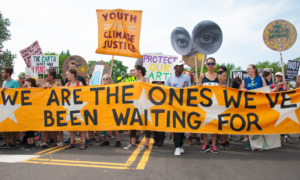By Grace Bauer, James Bell, Sarah Bryer, Jody Kent Lavy, Marcy Mistrett, Marc Schindler and Marie Williams
Like most people watching the unrest unfold in Baltimore on the night of April 27, we felt dismay and hoped that no one would be seriously injured or killed. We regretted the violence and looting, and worried that it might undermine the cause of those protesting the death of Freddie Gray while in police custody and the long history of police brutality in Baltimore.
But there we parted ways with many commentators — especially leaders at the local and national levels, who used dehumanizing language to stigmatize the youth involved in the unrest. These leaders referred to the teens and young adults engaged in the city’s protests as “criminals” and “thugs.” By doing so, they invoked harmful narratives about the young people involved, the motives behind their actions and the kinds of solutions that are needed.
Several commentators have already weighed in on this issue. As people who lead national organizations working to ensure that our children are recognized and treated as youth — and not little adults — when they get into trouble, we believe it is important that we weigh in, as well.
Some of these leaders later apologized for referring to Baltimore youth as “thugs.” But none has apologized for branding these young people as “criminals” — a term that presumes their guilt and which was not, we noticed, reflexively applied to the predominantly white youth in Lexington, Ky., who, in early April, rioted when Kentucky lost its game in the Final Four.
Most of us learn as young children that name-calling is ugly and harmful. As adults, we know that labelling people leads us to dehumanize them. The fact that our leaders were so quick to label the black teens and young men in Baltimore may be explained, after a fashion, by a 2014 study by the American Psychological Association. It found that black boys as young as 10 are perceived as adults and fully responsible for their actions in a way that white children of the same age are not — and they are more likely to be dehumanized and be victims of police violence if they are accused of a crime.
That is, we simply refuse to let them to be children or make the allowances we do for other young people. Yet neuroscience and developmental psychology have taught us that the brain doesn’t fully mature until age 25. Until that happens, all young people are prone to risky, impulsive action, heedless of the consequences — especially in moments of high emotion and when with peers.
Is it any wonder that some youth, caught in a tense confrontation with police, would behave as these young people have?
But it’s not simply a matter of treating youth as older than they are. By referring to them as thugs and criminals, politicians implied that these young people were acting without provocation. The reality is quite different.
The area where Freddie Gray lived and the protests have been centered is the poorest in the city and one of the poorest in the country. A March 2015 report from the Justice Policy Institute found that along with higher unemployment, higher rates of chronic school absence and much lower life expectancy than the city average, Freddie Gray’s community (Sandtown-Winchester/Harlem Park) sends the most people to prison of any Baltimore neighborhood. Young people from communities such as Sandtown are often over-represented in the criminal justice system and are more likely to be sentenced to extreme prison terms, such as life in prison.
We know there have been attempts to solve the challenges of communities like Sandtown before. If we are to make real progress in addressing unemployment, poor housing, access to schooling and people’s treatment and health needs, then investment in these communities needs to be coordinated, enduring — and happening outside the justice system.
Yes, our children must be held accountable when they cause harm to others (just as the six police officers allegedly responsible for Freddie Gray’s death may be, now that they have been charged). But our children should not be dehumanized, reduced to what they did on their worst day.
We urge policymakers not to be reactive and, under the sway of damaging labels, give in to the inevitable calls for “tougher policing,” or enact stringent new policies that repress rather than address the root causes of young people’s disconnectedness from their communities. We urge them to look instead for ways to engage young people and communities that feel disenfranchised and at odds with their community’s leaders.
We also know from research that children are remarkably resilient. With the right mix of adult support and opportunities to grow and learn, all young people are capable of great change. The willingness of Sandtown’s young people (and adults) to protest peacefully and clean up after the violence shows that there is hope and pride in the community still, despite the trauma they have endured throughout their lives.
Let’s not crush it by expressing paltry and dehumanizing expectations: Instead, let’s have the courage to embrace and nurture their potential.
Grace Bauer is executive director of Justice for Families. James Bell is executive director of W. Hayward Burns Institute. Sarah Bryer is director of National Juvenile Justice Network. Jody Kent Lavy is executive director of Campaign for Fair Sentencing of Youth. Marcy Mistrett is executive director of Campaign for Youth Justice. Marc Schindler is executive director of Justice Policy Institute. Marie Williams is executive director of Coalition for Juvenile Justice.

























